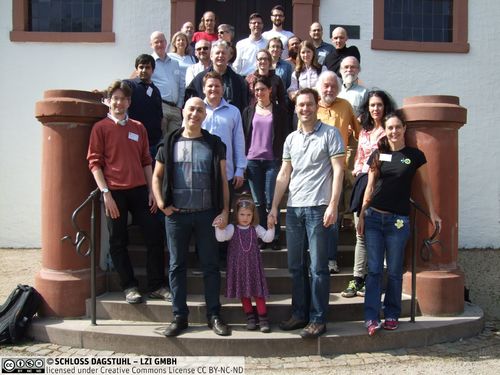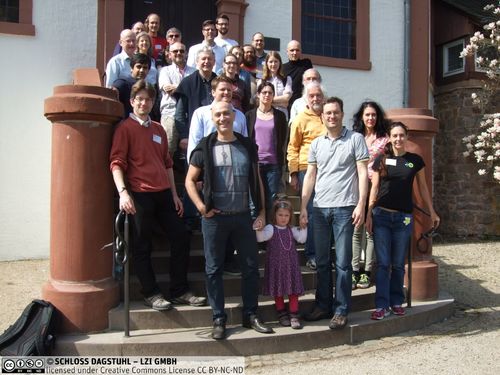Dagstuhl Seminar 14142
Spatial reference in the Semantic Web and in Robotics
( Mar 30 – Apr 04, 2014 )
Permalink
Organizers
- Aldo Gangemi (CNR - Rome, IT)
- Verena V. Hafner (HU Berlin, DE)
- Werner Kuhn (University of California - Santa Barbara, US)
- Luc Steels (Free University of Brussels, BE)
Coordinator
- Simon Scheider (Universität Münster, DE)
Contact
- Andreas Dolzmann (for scientific matters)
- Annette Beyer (for administrative matters)
Dagstuhl Seminar Wiki
- Dagstuhl Seminar Wiki (Use personal credentials as created in DOOR to log in)
Shared Documents
- Dagstuhl Materials Page (Use personal credentials as created in DOOR to log in)
Schedule
Places ("downtown"), spatial objects ("highway 1") and localized events ("hurricane Katrina"), are commonly referred to in the Semantic Web. They serve to search for and link to information across domains. Spatial reference systems, such as WGS841), allow for representing such references as points or regions. This makes them amenable not only for mapping, but also for powerful location-based querying and computing.
Spatial references are also fundamental in embodied cognition and robotics. Egocentric and allocentric spatial reference frames underlie robot learning and interaction. Decades of research in cognitive robotics highlight the role of social interaction, joint attention, language games, and visual discrimination games in establishing referents for symbols. The most well-known experiment is that of the Talking Heads. Spatial relations, such as right, front, left, behind, serve to name and identify other objects in a self-organizing vocabulary. Affordance-based cognition is a source of spatial reference in robots. However, so far, this research is only loosely connected to information science and the Semantic Web.
Existing options to localize information in the Semantic Web and in Robotics through coordinate systems cover only limited cases of spatial reference. Humans localize referents in space in many ways, based on different tasks and spatial competencies. For example, the location of a workplace may be linked to people, tasks, and infrastructures. It can be specified in terms of a coordinate system or, alternatively, in terms of containment, connectedness and accessibility in a building; yet another option is to specify it by the possibility to perform certain activities, such as sitting or reading and writing at the workplace.
This Dagstuhl Seminar will bring together leading international researchers from the Semantic Web, Spatial Cognition, Geo-informatics and Cognitive Robotics areas to work on the application, synthesis, formal construction, extension, and use of spatial reference systems, identifying challenges and research opportunities.
A closer connection of Cognitive Robotics and Semantic Web would provide particularly attractive options for research. For example, robot reference systems can be used in order to describe things accessible in the world, and Semantic Web technology to publish those descriptions for better information access. And vice versa, spatial referents and descriptions in the Semantic Web may guide robots towards accessible things in the world. Robots may function as surrogates of human observers and actors exchanging information on the Web of Data encoded in terms of their reference systems.
The following questions will be dealt with: 1. How can spatial reference systems improve search and integration in the Semantic Web? 2. How can spatial reference systems used in Robotics and the Semantic Web be made more adequate, flexible, and powerful? 3. How can the appropriateness of spatial reference systems be tested formally and empirically? Which spatial calculi and other formalisms support computations with spatial reference systems? 4. How can empirical evidence of spatial reference systems be found and in what sources? Dialogue corpora about directions and orientation? Narrative structures involving spatial referents? 5. How can we construct new kinds of reference systems for indoor and outdoor places? 6. What is the role of action-perception cycles, action simulation, social interaction, and joint attention in establishing spatial reference?
In order to focus discussions and make progress on each of these questions, the seminar will be organized around the use case of building an indoor mapping system for office workplaces. This system should allow for establishing place referents by various means, including robot and human interaction, in order to localize work resources, such as people, tasks, rooms, and activities.
- The world geodetic system https://en.wikipedia.org/wiki/World_Geodetic_System, a standard reference ellipsoid and coordinate frame for encoding locations on the earth surface.
Motivation
Places ("downtown"), spatial objects ("highway 1") and localized events ("hurricane Katrina"), are commonly referred to in the Semantic Web. They serve to search for and link to information across domains. Spatial reference systems, such as WGS84, allow for representing such references as points or regions. This makes them amenable not only for mapping, but also for powerful location-based querying, navigation support and computing.
Spatial references are also fundamental in embodied cognition and robotics. Egocentric and allocentric spatial reference frames underlie robot learning and interaction. Decades of research in cognitive robotics highlight the role of social interaction, joint attention, language games, and visual discrimination games in establishing referents for symbols. The most well-known experiment is that of the Talking Heads. Spatial relations, such as right, front, left, behind, serve to name and identify other objects in a self-organizing vocabulary. Affordance-based cognition is a source of spatial reference in robots as well as in humans. However, so far, this research is only loosely connected to information science and the Semantic Web.
Existing options to localize information in the Semantic Web and in Robotics through coordinate systems cover only limited cases of spatial reference. Humans localize referents in space in many ways, based on different tasks and spatial competencies. For example, the location of a workplace may be linked to people, tasks, and infrastructures. It can be specified in terms of a coordinate system or, alternatively, in terms of containment, connectedness and accessibility in a building; yet another option is to specify it by the possibility to perform certain activities, such as sitting or reading and writing at the workplace.
The seminar
This Dagstuhl Seminar brought together leading international researchers from the Semantic Web, Spatial Cognition, Geo-informatics and Cognitive Robotics to work on the application, synthesis, formal construction, extension, and use of spatial reference systems, identifying challenges and research opportunities. The seminar gathered 27 researchers, 9 from Spatial Cognition and reasoning, 6 from Geo-informatics, 7 from Cognitive Robotics, and 5 from the Semantic Web.
Seminar participants identified a number of concrete links between these communities that are being exploited for future research and development. For example, spatial reference systems of robots and corresponding cognitive spatial concepts can be used in order to describe resources accessible in the world, and Semantic Web technology to publish those descriptions for information access. Locations can be described in ways which are more closely related to humans, based on qualitative relations and environmental referents, and for environments which are difficult to localize by a GPS. In this way, it becomes possible to share location descriptions among humans and robots and thus to localize resources of interest (e.g. rooms, people, places) published in the Web of data. Vice versa, spatial referents and descriptions in the Semantic Web may guide robots towards accessible things in the world. Robots may function as embodied surrogates of human observers exchanging information on the Web of Data encoded in terms of their own reference systems.
 Aldo Gangemi and Verena V. Hafner and Werner Kuhn and Simon Scheider and Luc Steels
Aldo Gangemi and Verena V. Hafner and Werner Kuhn and Simon Scheider and Luc Steels
- Brandon Bennett (University of Leeds, GB) [dblp]
- Mehul Bhatt (Universität Bremen, DE) [dblp]
- Sasa Bodiroza (HU Berlin, DE) [dblp]
- Martin V. Butz (Universität Tübingen, DE) [dblp]
- Nicholas Chrisman (RMIT University - Melbourne, AU) [dblp]
- Helen Couclelis (University of California - Santa Barbara, US) [dblp]
- Anne Cregan (Intersect - Sydney, AU) [dblp]
- Max J. Egenhofer (University of Maine, US) [dblp]
- Andrew U. Frank (TU Wien, AT) [dblp]
- Christian Freksa (Universität Bremen, DE) [dblp]
- Aldo Gangemi (CNR - Rome, IT) [dblp]
- Giancarlo Guizzardi (UFES - Vitoria, BR) [dblp]
- Verena V. Hafner (HU Berlin, DE) [dblp]
- Pascal Hitzler (Wright State University - Dayton, US) [dblp]
- Werner Kuhn (University of California - Santa Barbara, US) [dblp]
- Bruno Lara Guzman (National University of Mexico, MX) [dblp]
- Vivien Mast (Universität Bremen, DE) [dblp]
- Mihoko Niitsuma (Chuo University, JP) [dblp]
- Kai-Florian Richter (Universität Zürich, CH) [dblp]
- Katharina J. Rohlfing (Universität Bielefeld, DE) [dblp]
- Yulia Sandamirskaya (Ruhr-Universität Bochum, DE) [dblp]
- Thomas Scharrenbach (Universität Zürich, CH) [dblp]
- Simon Scheider (Universität Münster, DE) [dblp]
- Michael Spranger (Sony - Tokyo, JP) [dblp]
- Stephan Winter (The University of Melbourne, AU) [dblp]
- Stefan Wölfl (Universität Freiburg, DE) [dblp]
- Diedrich Wolter (Universität Bamberg, DE) [dblp]
Classification
- artificial intelligence / robotics
- semantics / formal methods
- society / human-computer interaction
Keywords
- Spatial reference systems
- Semantic Web
- Robotics
- Embodiment
- Spatial cognition



 Creative Commons BY 3.0 Unported license
Creative Commons BY 3.0 Unported license
